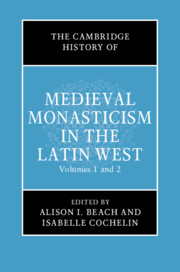Book contents
- The Cambridge History of Medieval Monasticism in the Latin WEST
- The New Cambridge History of Medieval Monasticism in the Latin West
- The Cambridge History of Medieval Monasticism in the Latin WEST
- Copyright page
- Contents
- Figures
- Contributors
- Acknowledgments
- Abbreviations
- 1 General Introduction
- Part I The Origins of Christian Monasticism to the Eighth Century
- Part II The Carolingians to the Eleventh Century
- Part III The Long Twelfth Century
- Part IV Forms of Monasticism in the Late Middle Ages
- 50 Late Medieval Monasticism: Historiography and Prospects
- 51 Sources of Late Medieval Monasticism
- 52 Monastic Liturgy, 1100–1500: Continuity and Performance
- 53 Books and Libraries within Monasteries
- 54 Art in Monastic Churches of Western Europe from the Twelfth to the Fourteenth Century
- 55 Lay Brothers and Sisters in the High and Late Middle Ages
- 56 Female Religious Life in the Twelfth and Thirteenth Centuries
- 57 Striving for Religious Perfection in the Lay World of Northern Europe
- 58 Monks and the Universities, c. 1200–1500
- 59 Bishops, Canon Law, and the Religious, c. 1140–1350
- 60 Daily Life in Late Medieval Monasteries
- 61 Monastic Preaching, c. 1350–1545
- 62 Research on Monasticism in the German Tradition
- 63 Satirical Depictions of Monastic Life
- 64 A Crisis of Late Medieval Monasticism?
- Index
- References
59 - Bishops, Canon Law, and the Religious, c. 1140–1350
from Part IV - Forms of Monasticism in the Late Middle Ages
Published online by Cambridge University Press: 16 January 2020
- The Cambridge History of Medieval Monasticism in the Latin WEST
- The New Cambridge History of Medieval Monasticism in the Latin West
- The Cambridge History of Medieval Monasticism in the Latin WEST
- Copyright page
- Contents
- Figures
- Contributors
- Acknowledgments
- Abbreviations
- 1 General Introduction
- Part I The Origins of Christian Monasticism to the Eighth Century
- Part II The Carolingians to the Eleventh Century
- Part III The Long Twelfth Century
- Part IV Forms of Monasticism in the Late Middle Ages
- 50 Late Medieval Monasticism: Historiography and Prospects
- 51 Sources of Late Medieval Monasticism
- 52 Monastic Liturgy, 1100–1500: Continuity and Performance
- 53 Books and Libraries within Monasteries
- 54 Art in Monastic Churches of Western Europe from the Twelfth to the Fourteenth Century
- 55 Lay Brothers and Sisters in the High and Late Middle Ages
- 56 Female Religious Life in the Twelfth and Thirteenth Centuries
- 57 Striving for Religious Perfection in the Lay World of Northern Europe
- 58 Monks and the Universities, c. 1200–1500
- 59 Bishops, Canon Law, and the Religious, c. 1140–1350
- 60 Daily Life in Late Medieval Monasteries
- 61 Monastic Preaching, c. 1350–1545
- 62 Research on Monasticism in the German Tradition
- 63 Satirical Depictions of Monastic Life
- 64 A Crisis of Late Medieval Monasticism?
- Index
- References
Summary
“The power of bishops is harmful to the monastic way of life (regimini religiosorum).” So the Cistercian abbot Jacques de Thérines (d. 1321) summed up the relationship between bishops and monks around the year 1300. Whether or not the abbot was correct about the effect of episcopal power, most scholars have agreed that tension, if not outright conflict, was a normal part of this relationship. To some extent this was inevitable. Tightly knit communities with a strong sense of vocation and heritage rarely welcome outside interventions, even if they are well-meaning. Nonetheless, there was also a happier aspect to monastic–episcopal relations. Bishops could act as patrons, providing monasteries with resources and defending their interests, while preventing serious internal abuses. Monasteries, for their part, could serve an important role for bishops’ flocks as pilgrimage sites, and centers for networks of devotion and learning.
- Type
- Chapter
- Information
- The Cambridge History of Medieval Monasticism in the Latin West , pp. 1093 - 1108Publisher: Cambridge University PressPrint publication year: 2020



